![]()
![]()
![]()
Use LEFT and RIGHT arrow keys to navigate between flashcards;
Use UP and DOWN arrow keys to flip the card;
H to show hint;
A reads text to speech;
47 Cards in this Set
- Front
- Back
|
What are the three parts of the occipital bone? |
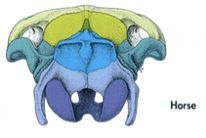
Squamous part - turquoise
Lateral part - sky blue Basilar part - azure |
|
|
What is the highest point of the skull in horses, sheep and goats? In the ox?
|
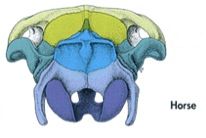
The nuchal crest of the occipital bone in the horse, sheep, and goats.
The intercornual protuberances frontal bone in oxen. |
|
|
Where does the funicular part of the nuchal ligament attach in horses?
|
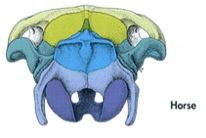
The external occipital protuberance.
|
|
|
Which bone in large animals does the hypoglossal foramen course through?
|
The occipital bone - the most caudoventral opening on the ventral part of the occipital bone
|
|
|
What separates the occipital bone from the front bone in oxen?
|
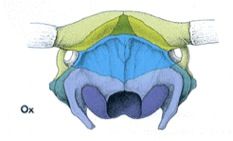
The parietal bone (the pea green, between the occipital (turquoise) and frontal (sage green)). This is more caudal than in other animals, where the parietal bone tends to be on the top of the skull
|
|
|
What is the nuchal crest called in oxen?
|
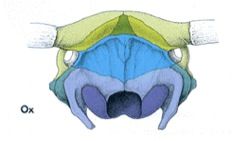
The nuchal line - it's not a crest in the oxen due to the parietal bone being at the caudal aspect of the skull and the frontal bone making up the top of the cranium. (nuchal line is between turquoise and pea green)
|
|
|
What foramen runs through the frontal bone in the horse and small ruminant (goat/sheep)? What about in the oxen?
What is the process of the frontal bone. |
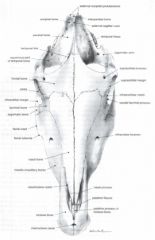
The supraorbital foramen in the horse and small ruminants, and foramina in the oxen (as there are many of them.
There is still the zygomatic process of the frontal bone in horses. |
|
|
What passes through the supraorbital foramen in horses?
|
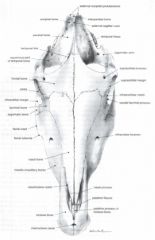
Supraorbital artery and nerve
|
|
|
Why is the frontal bone so much bigger in the bovid than in most species?
|
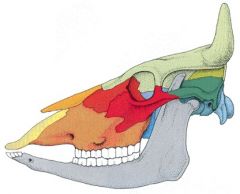
It's due to the large frontal sinus.
|
|
|
What is the osteological description of horns?
|
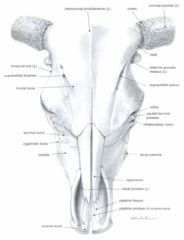
Cornual processes of the frontal bone.
|
|
|
What species does the parietal bone contribute to the dorsal aspect of the cranium?
|
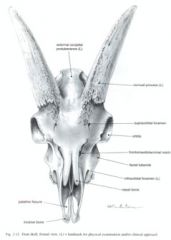
Really, all but the bovid, it seems. Here's a goat skull.
|
|
|
What is the continuation of the temporal line in horses and bovids?
|
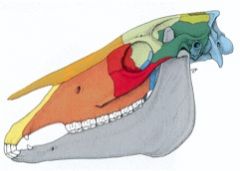
The temporal crest.
|
|
|
What are the three parts of the temporal bone?
|

Squamous (green), tympanic, and petrosal parts.
|
|
|
What four parts make up the squamous part of the temporal bone of the horse and ox?
|
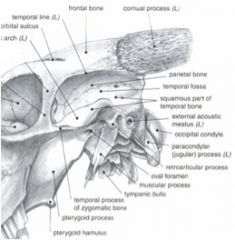
Mandibular fossa
Retroarticular process Retroarticular foramen Zygomatic process of the temporal bone (ox skull shown) |
|
|
What regions make up the tympanic part of the temporal bone of the horse and ox? What about the petrosal part?
|
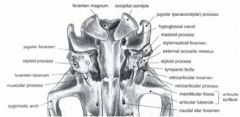
Tympanic part:
Tympanic bulla External acoustic meatus muscular process Petrosal part (external part): Mastoid process Styloid process Stylomastoid foramen (horse skull shown) |
|
|
What cranium hole do the CNs IX, X, XI, sympathetic trunk and internal carotid a pass through in the horse? What about ruminants?
|
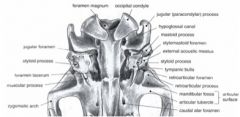
the tympano-occipital fissure in ruminants and the foramen lacerum in the horse
(horse skull shown) |
|
|
What are the two articulations of the temporal bone with non-skull bones?
|
Stylohyoid bone and mandible.
|
|
|
What four parts make up the ethmoid bone?
|
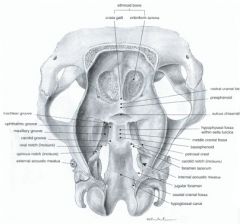
Cribriform plate
Cribriform foramina Perpendicular bone Crista galli - Continuation of the perpendicular bone; protrudes into the cranial cavity, dividing the brain and olfactory bulbs into two parts. This is a horse skull. |
|
|
What are the differences and similarities between the horse and ruminant maxillary bone?
|
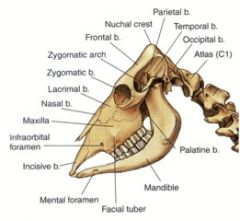
Horses have facial crests where ruminants have lacrimal bulla and facial tuberosities.
In common, they have: maxillary foramen, infraorbital canal, infraorbital foramen, osseous lacrimal canal, palatine process of the maxilla (portion of the hard palate), and dental alveoli. |
|
|
What is the space between the nasal bone and incisive bone called in large animals?
|
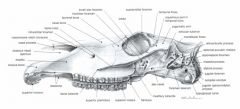
The nasoincisive notch.
|
|
|
T/F Maxillary bone articulates with all of the facial bones and temporal and frontal bones of the neurocranium.
|
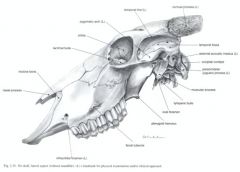
True.
ox skull shown. |
|
|
What are the three main bones forming the bony orbit in all domestic animals?
|
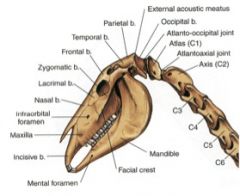
Frontal, lacrimal and zygomatic
(horse skull shown) |
|
|
What forms the boundaries of the choana in all animals?
|
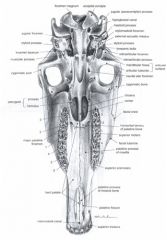
The palatine bone.
(horse skull shown) |
|
|
What is the unique feature of the sheep maxillary bone?
|
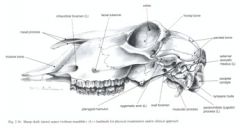
Sheep have external lacrimal fossa. The lacrimal pouch sits in it - a cutaneous pouch that secretes fatty, sticky, yellow material.
|
|
|
What foramen does the mandibular branch of trigeminal n. pass through in horses?
|
The oval notch at the rostral edge of the foramen lacerum.
|
|
|
T/F The foramen of the pterygopalatine fossa and what passes through them is the same in the horse as in the dog.
|
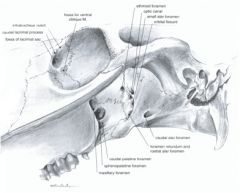
False - Ethmoid foramen, optic canal, orbital fissure, alar canal are all the same (including what exits them), but the oval foramen in the dog, is the oval notch in the horse that is located at the rostral extent of the foramen lacerum. Mandibular br. of trigeminal passes through this.
|
|
|
T/F The foramen of the pterygopalatine fossa and what passes through them is the same in the bovid as in the dog.
|
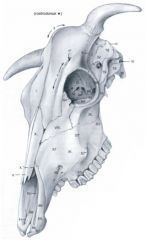
False. The ethmoid foramen, optic canal, and oval foramen are the same, but there is a foramen orbitorotundum (44"). This foramen is a meeting of the orbital fissure and round foramen, so through it passes, 3, 4, 5 (ophthalmic), and 6.
|
|
|
How can you distinguish a ruminant mandible from an equine mandible?
|
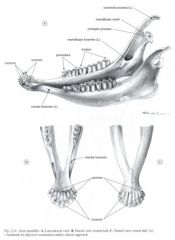
The ruminant mandible (shown from a goat) has coronoid processes that curve caudally, where the equine one are straighter.
|
|
|
What type of joint is the temporomandibular joint?
|
A condylar joint.
|
|
|
What are the two compartments of the temporomandibular joint meniscus?
|
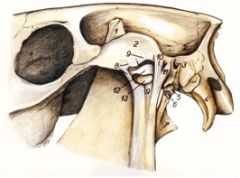
Fibrocartilaginous meniscus (12) is located between the two articular surfaces of the joint
Two compartments: Dorsal meniscotemporal More extensive Ventral meniscomandibular |
|
|
What is the joint capsule of the temporomandibular joint reinforced by in the horse? In ruminants?
|
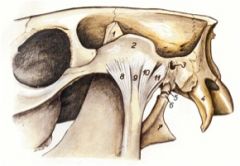
Joint capsule (9) is reinforced by lateral (8) and caudal (10, 11) ligaments in the horse
The caudal ligament is absent in ruminants allowing for more extensive transverse movement of the mandible (horse skull shown) |
|
|
Which bone of the hyoid apparatus is quite diminished in the horse?
|
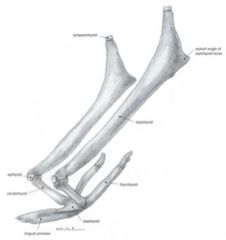
The epihyoid - it's pea-shaped.
|
|
|
What modification do the basihyoid bones have in large animals? Is it bigger in horses or ruminants?
|
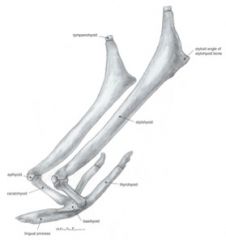
The lingual process. It is larger in horses.
(horse hyoid shown) |
|
|
What do the stylohyoid and thyrohyoid bones articulate with in the horse?
|
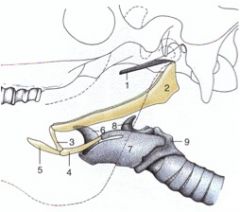
Stylohyoid bone articulates with the styloid process of the temporal bone via the tympanohyoid cartilage
Thyrohyoid bone articulates with the rostral cornu of the thyroid cartilage |
|
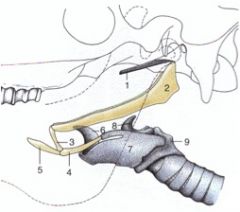
ID these numbers
|

1. Cartilage of the auditory tube
2. Stylohyoid bone 3. Ceratohyoid bone 4. Thyrohyoid bone 5. Lingual process of the basihyoid bone 6. Epiglottic cartilage 7. Thyroid cartilage 8. Arytenoid cartilage 9. Cricoid cartilage |
|
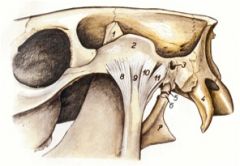
ID 5, 6, 7
|

5. Styloid process
6. Tympanohyoid cartilage 7. Stylohyoid bone |
|
|
empty
|
empty
|
|
|
What are the three cranial joints that Dr. Mansouri mentioned are joined by synchondrosis through hyaline transformation to bone?
|
Intersphenoid (between basi and pre), intraoccipital (between the occipital parts), and spheno-occipital joint.
|
|
|
T/F Ruminants don't have transverse foramen in C1.
|
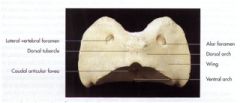
True. They have alar foramen instead. In dogs, this was the alar notch. Horses have both transverse and alar foramen.
(bovid C1 shown) |
|
|
T/F Lateral vertebral foramen is present in C1 in all species
|
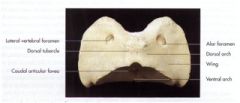
True
(bovid C1 shown) |
|
|
T/F Lateral vertebral foramen is present in C2 in all species
|

False - dogs don't have the lateral vertebral foramen in C2. All species have it in C1.
(horse axis shown) |
|
|
Where are the two joint capsules of the atlanto-occipital joint?
|
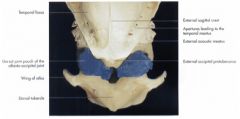
Dorsal capsule is located between the dorsal arch of the atlas and the dorsal rim of the foramen magnum
Ventral capsule is located between the ventral arch of the atlas and the rim of the foramen magnum (dorsal view shown) |
|
|
What type of joint is the atlanto-occipital joint? What about the atlanto-axial joint?
|
Atlanto-occipital joint:
Condylar joint with hinge movement - extension and flexion. Atlanto-axial joint: Pivot joint – the atlas and head rotate upon the axis; the axis of rotation passes through the body of the axis |
|
|
How many joint capsules does the atlanto-axial joint have?
|
One loose joint capsule – allows extensive movement. Does not communicate with the atlanto-occipital joint.
|
|
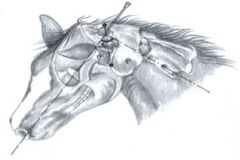
What are the three bony landmarks you would you use in the collection of CSF from the cerebellomedullary cistern in the horse?
|

Bony landmarks:
Wing of atlas Spinous process of axis External occipital protuberance |
|
|
What are the two bony landmarks you'd use for the collections of CSF from the cerebellomedullary cistern in the goat?
|
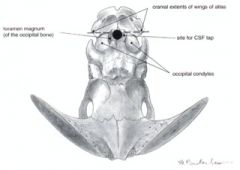
Occipital condyles and cranial extent of wing of atlas.
|
|
|
What three features can help you tell C7?
|
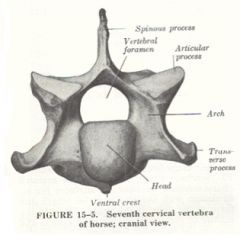
Transverse process not divided – just one part.
No transverse foramen. Caudal costal fovea for the head of the first rib. |

